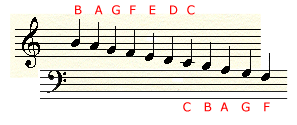Treble, Bass, Alto, and Tenor Clefs in Music Reading and Notation
Clefs
Pitches can be high or low. Since a staff only has five ledger lines it wouldn't make sense to put all these pitches on one staff; this is where clefs come in. Clefs theoretically move the staff up or down the pitch ladder.
Treble Clef:
A treble clef (sometimes known as the G clef) tells you that the note G is on the second line from the bottom of the staff. See how the curly part of the treble clef wraps around that line?

Instruments that generally use this clef include:
- Violin
- Saxophone
- Trumpet
- Clarinet
- Flute
Bass Clef:
A bass clef (sometimes known as the F clef), tells you that F is located on the fourth line from the bottom of the staff. Similar to the treble clef the bass clef also has a little curly thing that wraps around the line designated for F in this case.

Instruments that generally use this clef include:
- Tuba
- Trombone
- Baritone
- Bass
Notice the location of middle C on both of the staves. The bass clef picks up where the treble clef ends.

C Clef:
The last clef I'll throw at you is the C clef. This is an interesting one because it's movable up and down the lines of the staff to indicate where middle C is located.
Alto Clef
When the C clef is centered on the 3rd line of the staff it's called an alto clef, or viola clef.

Instruments that generally use this clef include:
- Viola
- Sometimes other alto voice instruments will use this clef…
Tenor Clef
If a C clef is moved up to the 4th line of the staff, thus indicating that the C is written on the 4th line, it's then known as a tenor clef. When reading notes written in tenor clef it may be helpful to know that the notes are simply one line or space higher than they would be in treble clef but they sound an octave lower.

Instruments that generally use this clef include:
- Bassoon
- Cello
